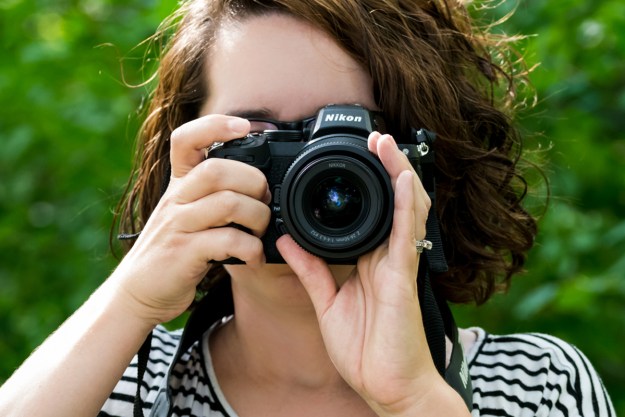It may not shoot 8K, but the full-frame Sony A7S III is the best video camera you can buy. While 8K will eventually become the norm, it remains well beyond the needs of today’s videographers.
The A7S III, which shoots gorgeous 4K video, is a practical and realistic choice for the modern content creator. After 5 years in development, the A7S III delivers a videographer’s wish list of features, with 4K at up to 120 frames per second, 10-bit 4:2:2 color, four-channel audio recording, five-axis in-body image stabilization (IBIS), and even 16-bit RAW video output. But as a high-end camera, the A7S III doesn’t come cheap. Not to worry, there are plenty of other great 4K video cameras — from action cams to other hybrid mirrorless models — that shoot excellent video for all levels of videographer.
If you are shopping on a budget, check out the best Black Friday camera deals we found.
At a glance:
- Best video camera overall: Sony A7S III
- Best 4K camcorder: Sony AX700
- Best video camera for YouTube: Sony A6600
- Best video camera for travel: Sony RX100 VII
- Best budget cinema camera: Blackmagic PCC4K
- Best hybrid still/video camera: Fujifilm X-T4
- Best DSLR for video: Nikon D780
- Best action camera: GoPro Hero9 Black
Best video camera overall: Sony A7S III
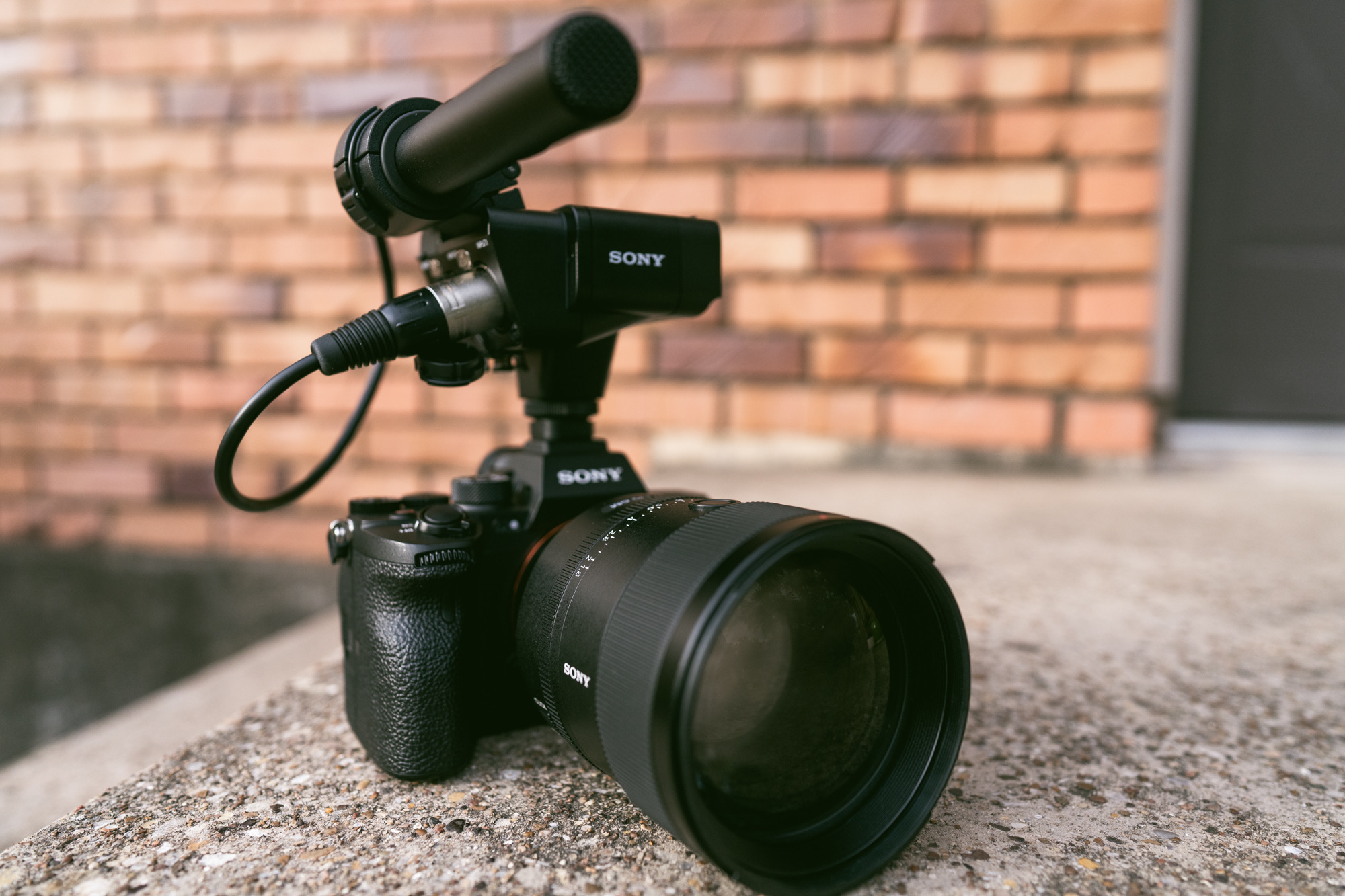
Why should you buy this: Exceptional, full-frame 4K video quality.
Who’s it for: Those who aren’t afraid to drop some cash for great image quality.
Why we picked the Sony AX700:
Sony didn’t completely rewrite the formula for the A7S III. Like the A7S II before it, it uses a 12-megapixel full-frame sensor. It is a new sensor, however, now backside-illuminated and with a lower base ISO of 80, features that should slightly improve noise levels and dynamic range. Measuring 4,240 pixels wide, the sensor actually delivers 4.2K video, although you can opt for basic 4K with a slight, 1.1X crop. Even at 4.2K, the camera can record 60 frames per second, but you’ll have to drop to regular 4K to hit 120 fps.
Aside from the sensor resolution, everything else about this camera has changed, starting with how video is processed. Where previous Sony mirrorless cameras were limited to 8-bit video, the A7S III finally gains 10-bit 4:2:2 color — all the way up to 4K/120. Combined with either Hybrid Log Gamma (HLG) or Sony’s S-Log3 color profiles, that means the A7S III is now ready for high dynamic range (HDR) production. Video can be recorded in either h.264 or h.265 compression at up to 280 megabits per second, or in a new all-intraframe codec at up to 600Mbps, which will result in larger files but will be less intensive on your computer when it comes to editing.
But it gets even better. If you opt to record externally over the HDMI port, the A7S III can pipe out 16-bit RAW video. That should mean even greater dynamic range and color depth when paired with an Atomos Ninja V or other RAW-capable external recorder.
However, even the best video camera is nothing without great audio, and the A7S III also delivers here. When using the optional XLR microphone adapter, the camera can save four independent audio channels internally. One common use for this would be to combine two external mics with the camera’s built-in stereo mic. And, yes, there’s a headphone jack.
The Sony A7S III also boasts several features that both still and video shooters will appreciate, like the new electronic viewfinder that boasts over 9 million pixels. It’s the highest-resolution EVF from any manufacturer, and gives photographers and videographers a bright, detailed view of the scene. The sensor-shift stabilization system is good for 5.5 stops of shake deduction and works in conjunction with Sony’s optically stabilized lenses for the best results. The autofocus system is also all-new, featuring on-chip phase-detection with face and eye-tracking that bring the A7S series in line with Sony’s other mirrorless cameras. And finally, the menu system has been completely redesigned and allows for separate photo and video settings to be stored. This may seem like a minor change, but a more efficient menu removes one of the biggest pain points we’ve had with Sony cameras.
Read our hands-on impressions of the Sony A7S III
Best 4K camcorder: Sony AX700

Why should you buy this: Beautiful 4K footage from a large, 1-inch sensor and bright zoom lens.
Who’s it for: Those who aren’t afraid to drop some cash for great image quality.
Why we picked the Sony AX700:
I’m not a big fan of camcorders, and I think your smartphone is an adequate substitute for many situations. But, the Sony AX700 makes a strong case for itself with a good balance of portability and image quality. Camcorders are also a good choice for live events, from weddings to sports, where you need a camera that can keep shooting uninterrupted for a long period of time.
Sony’s 1-inch-type sensors have dominated the compact camera market for years, and while those same sensors are newer to video cameras, they are no less impressive here, where they offer superior image quality to the usual 1/2-inch or smaller sensors found in camcorders. The 1-inch sensor in the AX700 helps it gather more light, bringing a serious image quality boost. Combined with the S-Log flat color profile, you can preserve more dynamic range to push the exposure and color further in post, if you feel like getting that in-depth.
The larger a sensor is, the harder it is to put a long zoom lens in front of it, but Sony still managed to tack on a 12X zoom to the AX700. The f/2.8-4.5 aperture is bright for the category, working together with the larger sensor to improve image quality in low light scenes. On the flip side, a built-in neutral density filter will assist when the surroundings are too bright, helping to keep the shutter speed down so that video doesn’t look jittery.
The sensor and lens work together with a 273-point phase-detection autofocus for smoother focusing with more accurate subject tracking. 4K video is recorded at 100 megabits per second, not as high as the likes of the Blackmagic PCC4K, but higher than the average consumer-grade video camera. Additional capabilities like HDR (high dynamic range) mode, 960-frames-per-second super slow-motion, and a hot shoe connection round out the feature set.
On the exterior, the camera offers a handful of manual controls including a multi-function lens ring that can control focus or zoom. Dual SD card slots allow for plenty of storage and uninterrupted recording.
The price of the Sony AX700 is a bit steep for many buyers, but right in line for the class. Canon’s competing Vixia HF G60 is a slightly more affordable alternative. It also offers a 1-inch sensor, but with an even longer 15X zoom and the same f/2.8-4.5 aperture. It lacks the super slow-motion mode and some other advanced features of the Sony, however.
The best video camera for YouTube: Sony A6600

Why should you buy this: Excellent autofocus, good video quality, and 5-axis image stabilization.
Who’s it for: One-person crews who need a camera that’s reliable even when nobody is standing behind it.
Why we picked the Sony A6600:
There are many great options when it comes to choosing a video camera to help take your YouTube channel to the next level, but none that will make capturing great footage as easy as the Sony A6600. While this camera is loaded with tons of powerful features, there is one that really stands out when it comes to shooting video for YouTube. That’s Sony’s Real-Time Eye and Real-Time Tracking autofocus, which is hands-down the best continuous focusing tech we’ve ever seen. For YouTubers who need to be on-camera and don’t have the luxury of working with another person as a camera operator, Real-Time Eye AF will keep you in sharp focus even if you need to move around within the frame.
That’s not the only thing that makes the A6600 a great video camera. It also shoots oversampled 4K video from its APS-C sensor for detail-rich output. The LCD screen can flip up 180 degrees so you can monitor yourself while on camera. Dedicated microphone and headphone jacks allow you to upgrade the audio quality without any bulky accessories. The five-axis sensor-shift stabilization system keeps your videos smooth and steady when shooting handheld (think vlogging). The short flange-back distance of the Sony E mount also makes the A6600 very adaptable to other lenses, including those from Canon and Nikon DSLRs, which opens up a world of creative lens options.
On top of all of this, the A6600 is also a top-notch still camera and is compact enough for travel. For jobs that require photography and video, you can knock both tasks out with the same tool.
But let me address the elephant in the room, the Panasonic Lumix GH5. The GH5 offers higher-quality 10-bit video files and some other pro-level features the Sony A6600 lacks. I think it’s an excellent choice — but, Panasonic’s contrast-detection autofocus simply doesn’t keep up with Sony’s better technology, and I think the average YouTuber will find the A6600 a bit easier to work with because of this.
Read our Sony A6600 hands-on review
Best video camera for travel: Sony RX100 VII
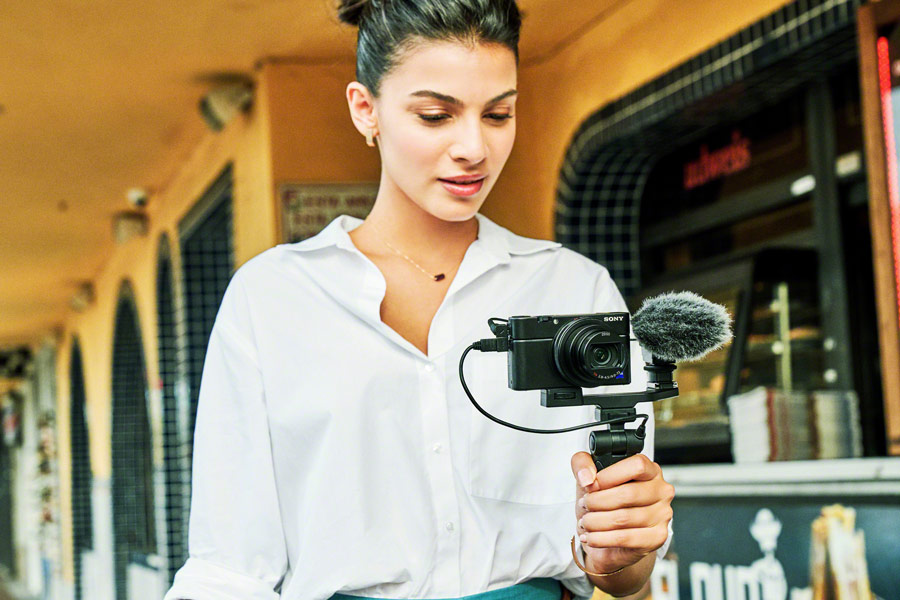
Why should you buy this: 4K video and excellent autofocus in a compact package
Who’s it for: Travel vloggers and anyone else who needs great video quality in a small form factor.
Why we picked the Sony RX100 VII:
While Sony recently announced a vlogger-oriented spinoff of the RX100 called the ZV-1, we haven’t had a chance to test it yet. For now, the RX100 VII remains listed here. Regardless of how good the ZV-1 turns out to be, the RX100 has at least one potential advantage for travel videos: a longer zoom lens.
The seventh iteration of Sony’s class-defining RX100 brings a wealth of advanced features to the compact camera. Not only does the RX100 VII offer the most impressive video feature set of the series, but it also happens to excel at still photos, giving you a one-size-fits-all device for travel. It uses a 20-megapixel 1-inch sensor (the same physical size as the AX700 above) matched with a fast Bionz X processor for detailed images and fast performance. The 24-200mm, 8X zoom lens isn’t long compared to a camcorder, but it’s an impressive amount of range for a camera that can easily slide into a jacket pocket.
4K video can be recorded at either 30 or 24fps, Full HD 1080p up to 120fps, and super slow-motion as high as 960fps at lower resolutions. Hybrid Log-Gamma (HLG) and S-Log profiles are also included for capturing more dynamic range and creating video suitable for playback on HDR televisions.
New to the Mark VII is Sony’s Real Time Tracking and Real Time Eye AF, the same focusing tech found in the A6600 mirrorless camera. This uses artificial intelligence to track moving subjects and keep them tack-sharp — in both still and video modes. Also new is a microphone jack (finally) that allows you to connect external microphones for better audio quality. All of these features mean the Sony RX100 VII doesn’t come cheap, but unlike traditional point-and-shoot cameras, it is built to last and should be viewed as an investment.
Best budget cinema camera: Blackmagic Design Pocket Cinema Camera 4K
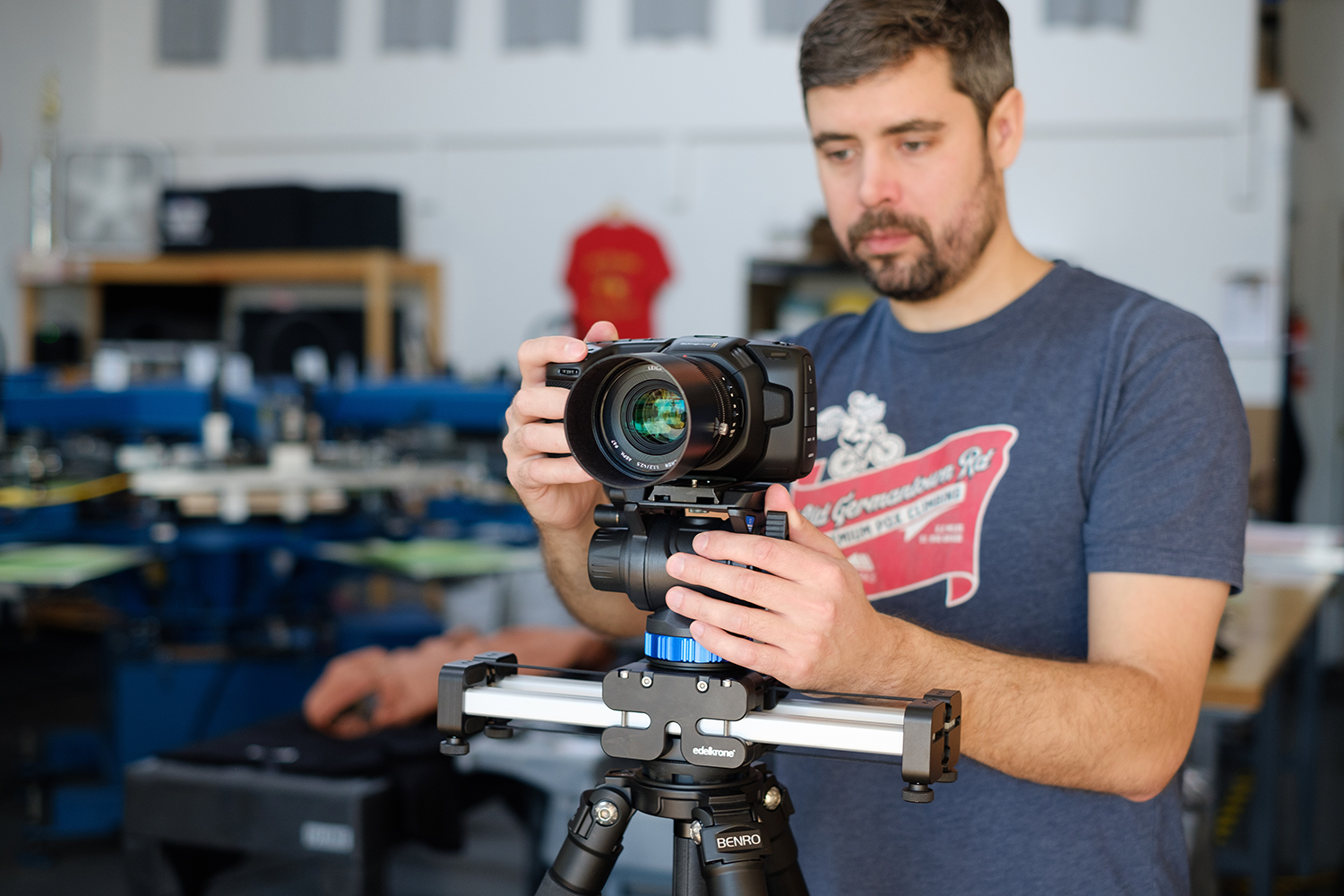
Why should you buy this: Professional cinema quality at an enthusiast-friendly price.
Who’s it for: Student, aspiring, and professional filmmakers.
Why we picked the Blackmagic Pocket Cinema Camera 4K:
The Pocket Cinema Camera 4K takes a lot of what makes Blackmagic Design’s professional Ursa Mini Pro 4.6K G2 camera special and serves it up at a fraction of the cost. Blackmagic Design is on a mission to lower the entry point for professional-quality film production, and the Pocket Cinema Camera 4K is its biggest step in that direction yet. It is considerably more affordable than other cinema cameras and even cheaper than many hybrid mirrorless cameras that lack its video chops. It’s built around the Micro Four Thirds system and uses a very similar sensor to the one found in the Panasonic Lumix GH5S.
In early 2020, Blackmagic Design also added remote camera control through the ATEM Mini series of livestream-ready HDMI switchers. This lets you use a connected computer to adjust exposure, color correction, and even focus and zoom on supported lenses. It turns the PCC4K into a viable studio camera, suitable for everything from professional livestream productions to a company Zoom meeting.
The camera features a gorgeous, 5-inch, Full HD display that is perhaps the best built-in monitor I’ve seen — although, it does not articulate. The touch interface is also brilliantly designed, making the PCC4K a surprisingly simple camera to use. Add the advanced audio inputs and controls, including both 3.5mm and mini-XLR, and you’ve got everything you need to make your next blockbuster.
Beyond the hardware, what really sets this camera apart from others is in the software. It records high-quality, edit-friendly filetypes including 10-bit Apple ProRes and even 12-bit Blackmagic RAW. Compared to the compressed formats most video cameras use, this means more detail and greater flexibility for color grading footage in post. You also get more options for storing that footage, as the camera records to SD or CFast 2.0 memory cards, or directly to an external solid-state drive (SSD) over USB 3.
Designed for workflows that involve a crew, the Pocket Cinema Camera doesn’t offer the creature comforts of most modern cameras. Autofocus is slow and often inaccurate, and there is nothing like the face or eye-tracking autofocus found on mirrorless cameras from the likes of Sony, Panasonic, Nikon, and Canon. It’s also designed to be a single component within a larger rig, and many operators end up spending hundreds — if not thousands — more on accessories to fully kit it out.
Even so, no other camera provides such a good starting point as the PCC4K for filmmakers who want the best quality on tight budgets.
Blackmagic Design has since released the Pocket Cinema Camera 6K, an upgrade over — but not a replacement of — the 4K version. In addition to the extra resolution, it offers a larger super 35 sensor and Canon EF lens mount. We still like the cheaper, smaller Blackmagic Design Pocket Cinema Camera 4K, but the 6K is worth a look if you demand even higher-quality video.
Read our Blackmagic Pocket Cinema Camera 4K review
The best hybrid still/video camera: Fujifilm X-T4
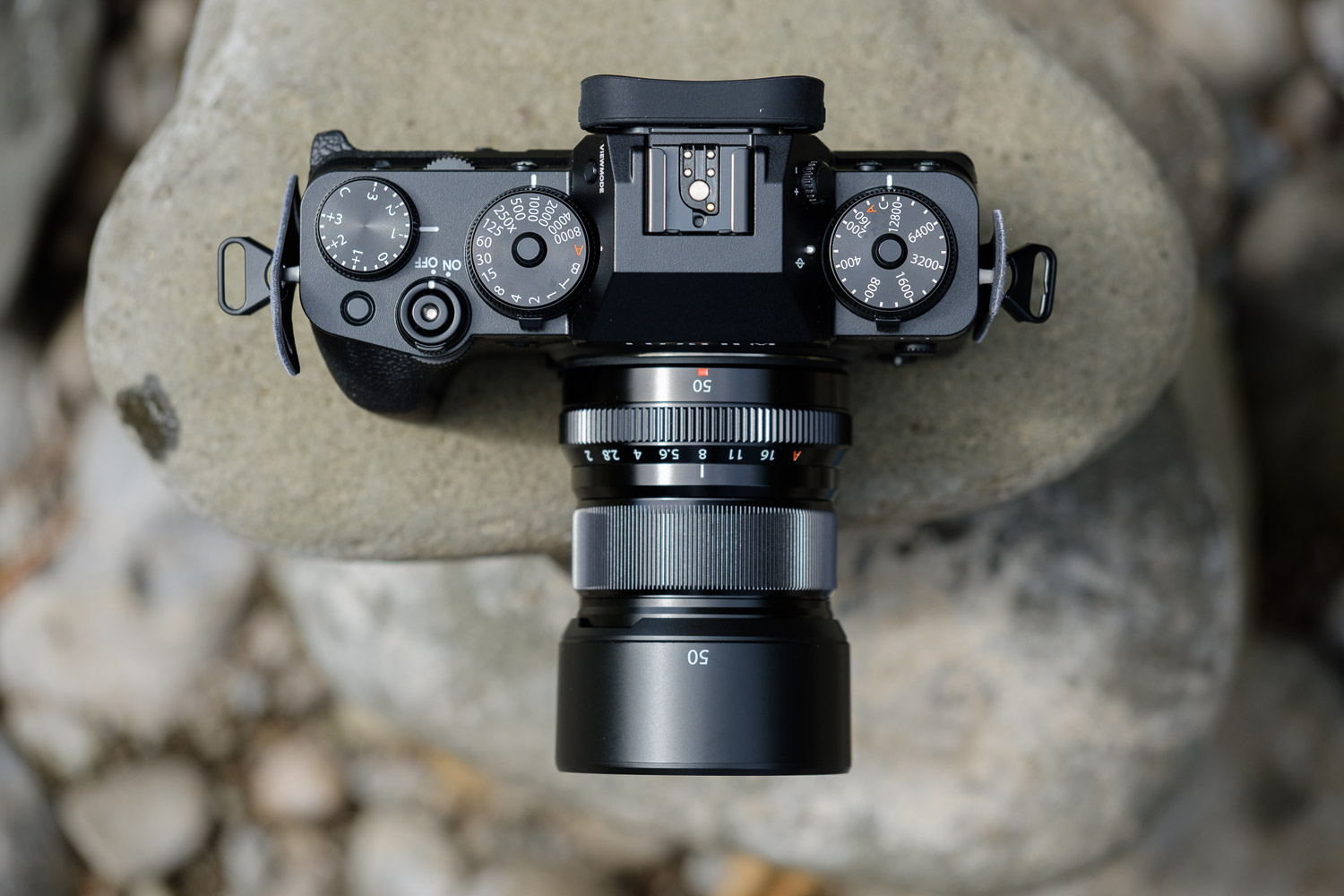
Why should you buy this: 5-axis stabilization, great 4K quality, articulating monitor
Who’s it for: Aspiring, enthusiast, and even professional video shooters.
Why we picked the Fujifilm X-T4:
Yes, a Fujifilm has made the list of best video cameras — and for great reasons. After cultivating a rabid following of enthusiast still photographers with its retro designs and fast prime lenses, Fujifilm set its eyes on video around the time of the X-T2. Two generations later and it has all but perfected it in the excellent X-T4.
The X-T4 is the first X-T camera to feature 5-axis internal stabilization, which is a boon for videographers looking to smooth out those otherwise shaky handheld shots. The camera also introduces a fully-articulating LCD screen so that talent-operators (like vloggers and YouTubers) can actually see themselves as they shoot, while the effective face- and eye-detection autofocus does a great job of staying locked on to the subject
Beyond this, the X-T4 serves up some of the most advanced video features of any mirrorless camera, with 10-bit 4K video at up to 400 megabits per second. 4K can be recorded at up to 60 frames per second, while Full HD is available at up to 240 fps for slow-motion playback. Fujifilm’s F-Log flat color profile provides for greater dynamic range, while the option to record externally brings even higher data rates and 4:2:2 color.
Compared to previous Fujifilm X-series cameras, the X-T4 also uses a higher-capacity battery, extending 4K video record time up to 110 minutes.
All the focus on video hasn’t changed Fujifilm’s core mission of delivering a top-notch photography experience. The Fujifilm X-T4 is one of the best mirrorless cameras we’ve tested, combing excellent image quality, a thoughtful control layout, and strong autofocus and continuous shooting performance into a portable (and surprisingly affordable) package.
Read our Fujifilm X-T4 hands-on review
Runner-up: Panasonic Lumix GH5
One thing the X-T4 lacks is time-limit-free recording. For most settings, clip length tops out at 20 minutes. This is where a camera like the Panasonic Lumix GH5 comes in. While several years old and with a smaller sensor than the X-T4, the GH5 remains a top contender in the video game, and one of the few cameras that puts no time limits on clip length. If you need a set-it-and-forget-it interview camera, or want to be able to go on a long-winded rant in your vlog, it’s the way to go.
The Panasonic Lumix GH5 also offers 10-bit internal recording at 400 megabits per second, 5-axis stabilization, and a fully articulating screen. Its smaller Micro Four Thirds sensor doesn’t have the resolution or low light sensitivity of the X-T4’s APS-C sensor, but it still takes decent still images, too.
Read our Panasonic Lumix GH5 review
The best DSLR for video: Nikon D780
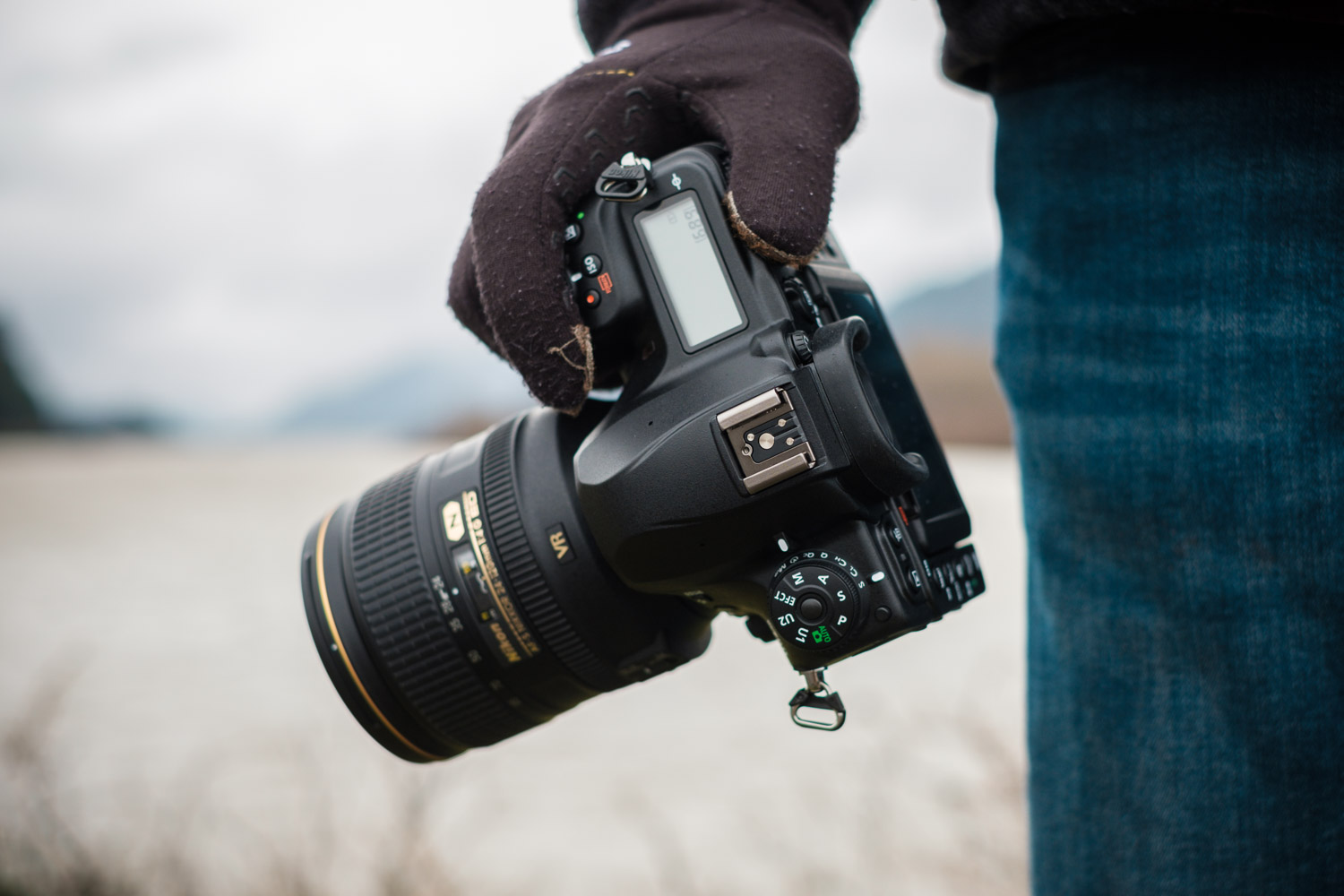
Why should you buy this: Professional 4K output and great autofocus.
Who’s it for: Photographers who need a capable one-camera solution for stills and video.
Why we picked the Nikon D780:
A DSLR wouldn’t be my first choice for shooting video. A DSLR’s optical viewfinder, beloved by many still photographers, is useless in live view mode, and therefore wasted on video. But that hasn’t stopped Nikon from giving its new D780 some serious video muscle. It’s not to the level of the the Canon EOS 1D X Mark III, but for a DSLR that doesn’t cost over six grand, you can’t beat the D780.
You’ll find an equally capable video camera in the smaller, cheaper, mirrorless Nikon Z 6, but if you’re a fan of DSLRs for photography and you know that’s the kind of camera you want, then the D780 is your best choice for a model that can also handle video. Well, at least one that doesn’t cost more than a used car.
Like any DSLR, the D780 is first and foremost a still camera and that’s the primary reason to buy it. With its 24-megapixel full-frame sensor, it isn’t the highest-resolution still camera out there, but it still shoots excellent photos with loads of dynamic range, beautiful colors, and great low light performance.
But if you need to shoot the occasional video, the D780 will get the job done with professional-quality results. The new on-chip phase-detection autofocus works great for video mode and includes a reliable face-detection feature (eye-detection is also available for still photography, but not video). This type of autofocus isn’t rare on mirrorless cameras, but this is the first Nikon DSLR to feature it.
The real benefits of the D780 come in the quality of its video. It shoots oversampled 4K from the full width of its sensor, leading to very detailed footage that looks great on any device, from a phone screen to the best 4K TVs.
You can even up your quality further by adding an Atomos Ninja V or similar HDMI video recorder. Internally, the D780 is limited to 8-bit 4:2:0 video, but it can output 10-bit 4:2:2 over HDMI, and doing so also opens up Nikon’s N-Log flat color profile which preserves more dynamic range. That gives you the features of a video-oriented mirrorless camera like the Lumix GH5, plus the benefits of a large full-frame sensor. Not too shabby.
One thing some customers will be disappointed with is the lack of a fully-articulating monitor. The D780’s LCD screen tilts up and down, but that’s it, making it poorly suited to vlog-style shooting.
The crop-sensor Canon EOS 90D is a good alternative at a cheaper price. It doesn’t offer a log profile or external 10-bit recording, but it features great autofocus and a fully-articulating monitor. That makes it a better camera for vlogging than the Nikon D780 (if vlogging with a DSLR is something you’d actually want to do). It’s also Canon’s first DSLR to record 4K from the full-width of the sensor, so your field of view w0n’t change between still and video modes.
Read our Nikon D780 review
The best action camera: GoPro Hero9 Black
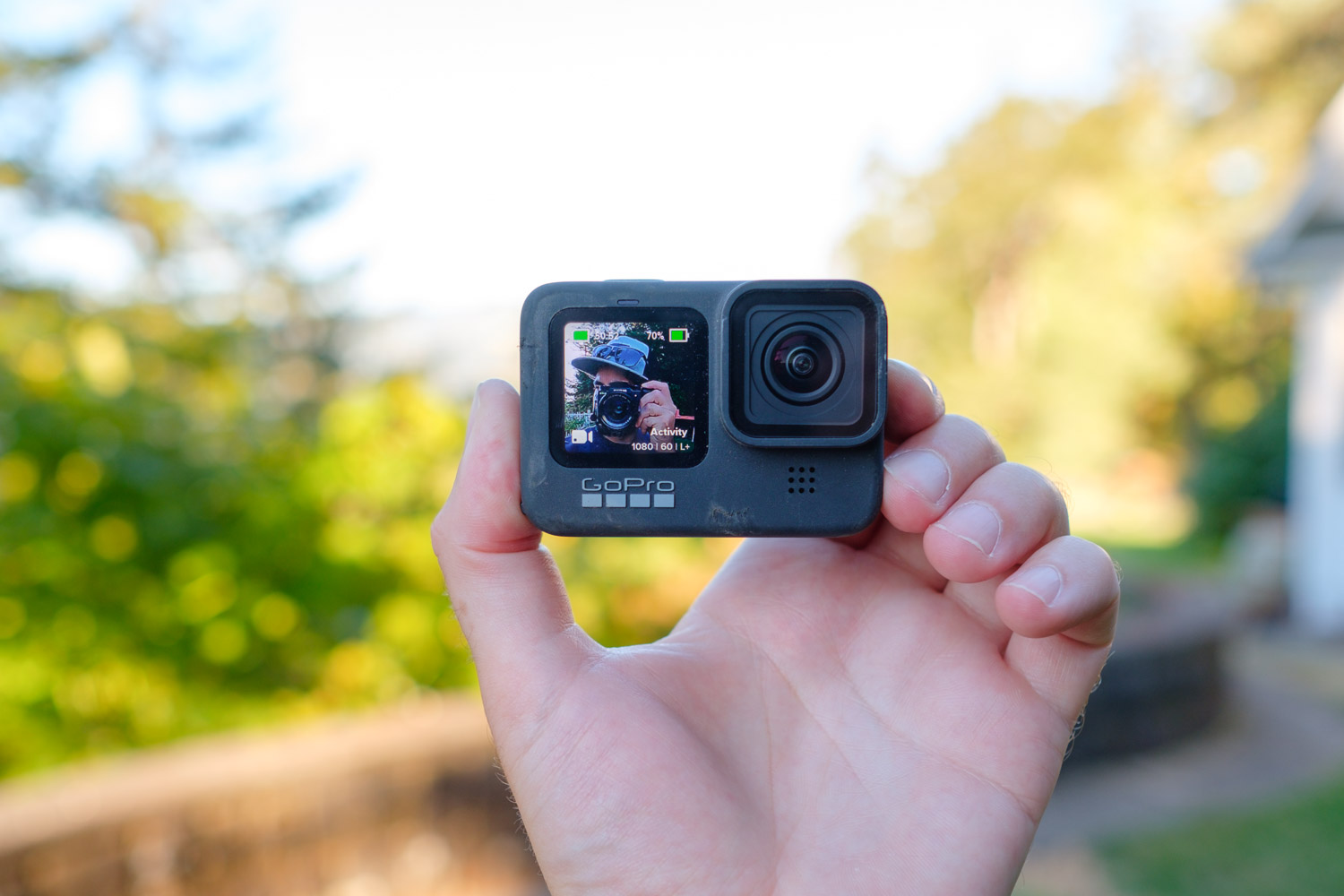
Why should you buy this: The most versatile feature set of any action camera
Who’s it for: Anyone with a love for POV videos or who needs a camera small enough to go anywhere.
Why we picked the GoPro Hero9 Black:
Calling the Hero9 Black an action camera isn’t the most accurate label. Yes, GoPro’s latest flagship is still the best action camera you can buy, but it does much more than provide a point-of-view perspective for extreme athletes. The front-facing screen makes it perfect for vlogging and a redesigned media mod, similar to the one introduced with the Hero8 Black, adds a mini shotgun microphone and two cold shoes for attaching other microphones or lights.
The Hero9 Black is physically larger than last year’s Hero8, but now features a bigger rear screen and higher-capacity battery. The removable lens cover, a beloved feature of the Hero5 through 7, also returns (although is incompatible with those older cameras). Not only does this make securing ND filters a breeze, but it also opens up support for the new Max Lens Mod, which expands the field of view to 155 degrees and enables 360-degree horizon leveling, meaning the camera can do a barrel role and your footage will remain upright the entire time.
Several software features have also received important updates. HyperSmooth 3.0 provides even better digital image stabilization with in-camera horizon leveling; TimeWarp 3.0 now allows you to slow down to either real time or half speed and records audio during real-time segments; and a number of automation tools allow you to program record starting times and durations.
All of this is to say nothing of the new sensor that shoots 20MP stills and 5K video — the latter of which I found to be little more than a marketing stunt, but, still, it’s the first new sensor in several generations of GoPro cameras. The Hero8 Black remains an excellent camera and is still available, but if you want the latest and greatest, nothing beats the GoPro Hero9 Black.
Read our full GoPro Hero9 Black review
Research and buying tips
- Why should I buy a video camera instead of using my phone?
- What are the key features of a video camera?
- Can video cameras take photos, and vice versa?
- What is a professional video camera?
- Should I buy a 4K video camera?
Why should I buy a video camera instead of using my phone?
In truth, not everyone needs a dedicated video camera anymore; our phones have great cameras in them that are good enough most of the time. There are a few key reasons why you may want a standalone camera, however.
Zoom lens
Your phone may have two (or five) lenses built into it, but if you need the versatility or reach of a long zoom, a camcorder is your best bet. Not only does this give you the ability to film subjects that are farther away, but camcorders also use powered lens motors that provide a very smooth zooming action.
Alternately, interchangeable lens cameras will grant added creative control, even if their lenses don’t zoom as far or as smoothly.
Battery life and record time
If you need to film a long event — from a little league game to a wedding ceremony — you probably don’t want to risk running down your phone’s battery. Particularly with mid-range and high-end camcorders, video cameras often offer multiple different sizes of battery, with high-capacity options designed for such situations. Mirrorless cameras, like the GH5 above, have optional battery grips that can be attached to extend battery life, while cinema cameras can be powered by large external batteries.
Image quality
If you want to achieve a cinematic look, you can do that relatively affordably with any DSLR or mirrorless camera. The combination of a large imaging sensor and interchangeable lenses grants much more creative control over the look and feel of your video, letting you shoot with a shallow depth of field and vastly improving low light performance over your phone.
Audio quality
Let’s face it: Your phone kind of sucks at recording audio, especially in a noisy environment. A dedicated video camera will not only have better built-in microphones, but it will also allow you to attach an external mic to get the best results in any given situation, from a wireless lavalier mic for recording dialogue, to a shotgun mic for cutting through ambient noise, to a stereo mic for recording music.
What are the key features of video cameras?
Video cameras can be broken down into four categories, each of which has unique advantages.
Action cameras
These are small, lightweight, and mountable cameras designed for “set it and forget it” applications. Strap one to your chest, stick it to your helmet, or mount it to your bike frame and just press record. Typically, these cameras are waterproof and ruggedized and can survive a beating.
Camcorders
Although not as popular as they once were (you can thank smartphones for that), camcorders still come in handy when you need a compact, all-in-one solution for recording video. They are characterized by having a zoom lens that is integrated into the camera body. Entry-level models are generally quite compact and able to be used one-handed, while higher-end models are larger and often include professional audio inputs and more controls.
DSLRs and mirrorless cameras
These are photo cameras that can shoot video — and some models are very good at it. The benefits are a large sensor and interchangeable lenses, which improve video quality and creative versatility over the likes of camcorders and action cams. Because of the larger sensors, you won’t find any extremely long zoom lenses like you get on camcorders, but you will be able to choose from a wide selection of lenses that give you vastly different looks.
Cinema cameras
These cameras, like the Blackmagic Pocket Cinema Camera that took the top spot on this list, share much in common with DSLRs and mirrorless cameras. They have relatively large sensors and interchangeable lenses. What separates them is the user interface, video-specific features, and higher-quality filetypes. Whereas most DSLRs and mirrorless cameras recorded highly compressed video, cinema cameras often offer uncompressed RAW files or lightly compressed filetypes like Apple ProRes. The higher-quality filetype means more flexibility in postproduction.
Can video cameras take photos, or vice versa?
Yes. Today, most DSLRs and mirrorless cameras are “hybrid” cameras, meaning they perform well for both stills and video, even if they are geared more toward still photography. Camcorders and cinema cameras can usually take photos, as well, but generally lack the resolution of a dedicated still camera. Whereas a mirrorless camera will easily have 20 or more megapixels, a camcorder or cinema camera tends to only have as many as it needs for video — for 4K resolution, that’s around 8MP.
What is a professional video camera?
While professional cameras tend to have better sensors and, likewise, better image quality, what really separates them from consumer models are the user interfaces and connectivity features. A professional video camera will have more direct access control — physical buttons and dials on the camera body — as well as a slew of input and output options for both audio and video. In the case of cinema cameras, these actually have fewer convenience features than consumer cameras — auto-focus and auto-exposure may be limited or nonexistent, for example.
Should I buy a 4K video camera?
The answer is probably yes, if for no other reason than 4K is quickly becoming the default. Even midrange mirrorless cameras now come equipped with 4K video. However, if you don’t have a 4K television or monitor, you won’t fully realize the benefits of a 4K video camera — and many people can’t see the difference, anyway. That said, shooting in 4K does allow you some flexibility to crop and reframe a shot in post, which can be a very welcome feature when you need it. It also does a much better job rendering fine patterns, like the threads in clothing, that may otherwise cause moiré at lower resolutions.
If you are shopping on a budget, check out the best Black Friday camera deals we found.
Editors' Recommendations
- Save $100 on the water-resistant GoPro Max 360 action camera
- Best Sony A7 III deals: Save $300 on the full frame mirrorless camera
- The 5 best laptops for photo editing and photographers
- The best webcams for Teams, Zoom, streaming, low light and more
- Best GoPro deals: Save on action cameras and accessories



